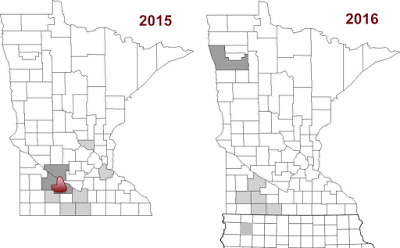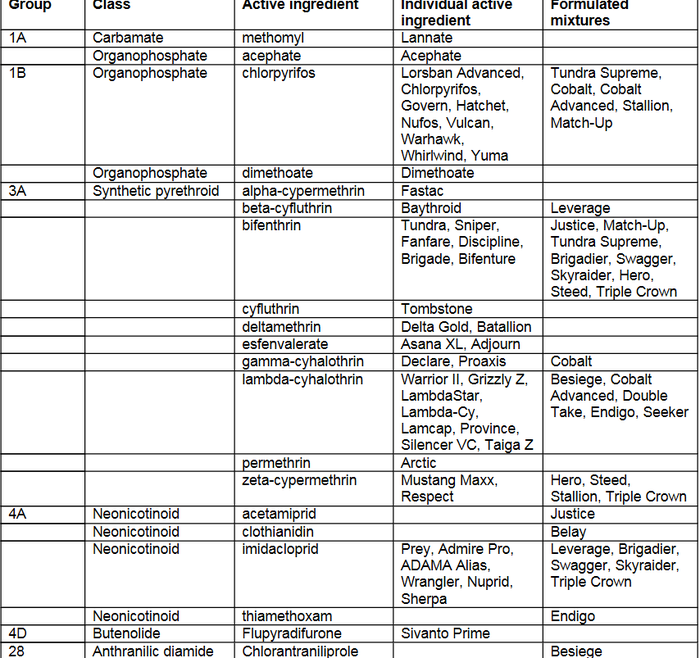July 24, 2017

By Robert Koch (Extension Entomologist), Ian MacRae (Extension Entomologist), Bruce Potter (Extension IPM Specialist), and Phil Glogoza (Extension Educator – Crops)
By now you should be scouting your soybean fields for soybean aphid on a regular basis. Soybean aphid can be found in most fields throughout the state and populations have reached economic threshold (250 aphids per plant) in some fields in northwest Minnesota and have require insecticide application to protect soybean yield. In northwest Minnesota (especially around Norman County), applications of pyrethroid insecticides are failing to adequately control aphid populations in some, but not all, fields.
This is the third year in a row that we have received reports of failures of pyrethroids to control soybean aphid in Minnesota. In 2015 and 2016, field-level failures of pyrethroid insecticides were reported (Figure 1) and pyrethroid resistant populations of soybean aphid were confirmed in Minnesota, particularly in parts of southwest Minnesota. In addition, a resistant aphid population was also found near Crookston in northwest Minnesota in 2016, just north of the area experiencing problems this year.

Figure 3: Locations of reported field-level performance problems of pyrethroids for soybean aphid management. Red indicates areas with more widespread reports of performance problems.
A few scattered fields at economic threshold have also been found in areas farther south this year. The susceptibility to pyrethroid insecticides of these aphid populations is not yet known. If aphid populations continue to build, fields in other parts of Minnesota could also require insecticide application in the coming weeks.
Here, we provide recommendations for management of soybean aphid with uncertain insecticide resistance status.
Insecticide choice: Despite the documentation of insecticide resistance in Minnesota, pyrethroid insecticides have worked well for soybean aphid control in most parts of the state the last two years. Therefore, these products may continue to work well for many soybean aphid applications. Use full labeled rates of insecticide and high water volumes.
However, an insecticide not containing a pyrethroid may be preferred for the first application, if threshold-level aphid infestations occur in fields in areas where:
1. failures were experienced in previous years (Figure 1) or
2. in the area experiencing failures this year (near Norman County).
See Table 1 at end of article for list of insecticides for soybean aphid control.
Post-treatment scouting: We can no longer assume our insecticide applications will always effectively control soybean aphid. Therefore, it is important to scout fields three to five days after an insecticide application to determine if adequate control of the pest was achieved. A follow-up application may be needed to protect yield.
Alternate insecticide groups: If an additional insecticide application is required for a field, switch to a different insecticide group (Table 1). Insecticide group numbers are listed on the label. Alternation of individual insecticide groups is generally more effective for insecticide resistance management.
Several formulated mixtures (pre-mixes) are labeled for soybean aphid management (Table 1). Use of insecticide mixtures is generally discouraged from the perspective of insecticide resistance management. Be aware that the different insecticides in some formulated mixtures are at reduced rates compared to products with single insecticides. Use of insecticide mixtures can further complicate alternation of insecticide groups for any additional applications that may be required. In addition, the value of the multiple insecticides in a mixture may be less if the pest has already developed resistance to one of the insecticides in the mixture.
Further resistance management recommendations can be found in “Insecticide resistance management in soybean”.
Determining resistance: Several factors can cause an insecticide application not to perform as expected. Before assuming resistance, you must rule out factors such as misapplication of the insecticide, unfavorable weather, and recolonization by the pest. Potential cases of soybean aphid resistance to insecticides can be reported directly to us, or through a U of MN Extension webpage “Report Insecticide Failures for Soybean Aphid”.
Scouting: A refresher on scouting recommendations for soybean aphid can be found in “Scouting for soybean aphid”. The average number of aphids per plant for a field should then be related to the economic threshold of 250 aphids per plan (with most plants infested and aphid populations increasing) to determine if an insecticide application is necessary. An overview of the economic threshold for soybean aphid and its continued validity for management of this pest can be found in “Just the facts: A review of the biology and economics behind soybean aphid insecticide recommendations”.
Originally posted by the University of Minnesota Extension.
Table 1: Foliar insecticides for soybean aphid.
Representative products

You May Also Like




